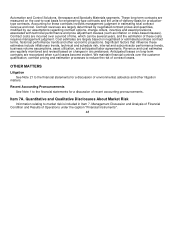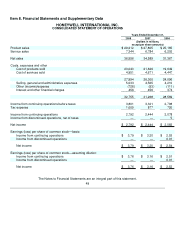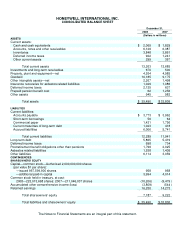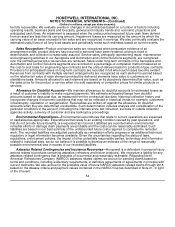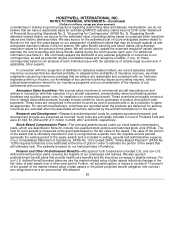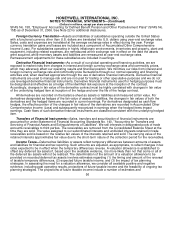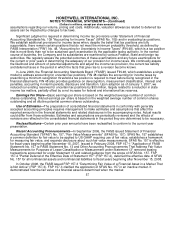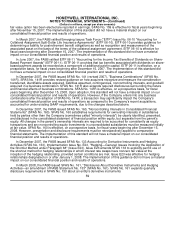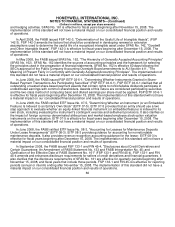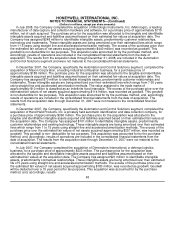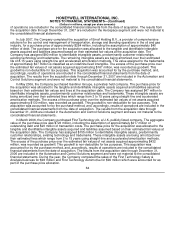Honeywell 2008 Annual Report Download - page 76
Download and view the complete annual report
Please find page 76 of the 2008 Honeywell annual report below. You can navigate through the pages in the report by either clicking on the pages listed below, or by using the keyword search tool below to find specific information within the annual report.
HONEYWELL INTERNATIONAL INC.
NOTES TO FINANCIAL STATEMENTS—(Continued)
(Dollars in millions, except per share amounts)
be fully recoverable. We evaluate events or changes in circumstances based on a number of factors including
operating results, business plans and forecasts, general and industry trends and, economic projections and
anticipated cash flows. An impairment is assessed when the undiscounted expected future cash flows derived
from an asset are less than its carrying amount. Impairment losses are measured as the amount by which the
carrying value of an asset exceeds its fair value and are recognized in earnings. We also continually evaluate the
estimated useful lives of all long-lived assets and periodically revise such estimates based on current events.
Sales Recognition—Product and service sales are recognized when persuasive evidence of an
arrangement exists, product delivery has occurred or services have been rendered, pricing is fixed or
determinable, and collection is reasonably assured. Service sales, principally representing repair, maintenance
and engineering activities in our Aerospace and Automation and Control Solutions segments, are recognized
over the contractual period or as services are rendered. Sales under long-term contracts in the Aerospace and
Automation and Control Solutions segments are recorded on a percentage-of-completion method measured on
the cost-to-cost basis for engineering-type contracts and the units-of-delivery basis for production-type contracts.
Provisions for anticipated losses on long-term contracts are recorded in full when such losses become evident.
Revenues from contracts with multiple element arrangements are recognized as each element is earned based
on the relative fair value of each element provided the delivered elements have value to customers on a
standalone basis. Amounts allocated to each element are based on its objectively determined fair value, such as
the sales price for the product or service when it is sold separately or competitor prices for similar products or
services.
Allowance for Doubtful Accounts—We maintain allowances for doubtful accounts for estimated losses as
a result of customer's inability to make required payments. We estimate anticipated losses from doubtful
accounts based on days past due, as measured from the contractual due date, historical collection history and
incorporate changes in economic conditions that may not be reflected in historical trends for example, customers
in bankruptcy, liquidation or reorganization. Receivables are written-off against the allowance for doubtful
accounts when they are determined uncollectible. Such determination includes analysis and consideration of the
particular conditions of the account, including time intervals since last collection, success of outside collection
agencies activity, solvency of customer and any bankruptcy proceedings.
Environmental Expenditures—Environmental expenditures that relate to current operations are expensed
or capitalized as appropriate. Expenditures that relate to an existing condition caused by past operations, and
that do not provide future benefits, are expensed as incurred. Liabilities are recorded when environmental
remedial efforts or damage claim payments are probable and the costs can be reasonably estimated. Such
liabilities are based on our best estimate of the undiscounted future costs required to complete the remedial
work. The recorded liabilities are adjusted periodically as remediation efforts progress or as additional technical,
regulatory or legal information becomes available. Given the uncertainties regarding the status of laws,
regulations, enforcement policies, the impact of other potentially responsible parties, technology and information
related to individual sites, we do not believe it is possible to develop an estimate of the range of reasonably
possible environmental loss in excess of our recorded liabilities.
Asbestos Related Contingencies and Insurance Recoveries—Honeywell is a defendant in personal injury
actions related to products containing asbestos (refractory and friction products). We recognize a liability for any
asbestos related contingency that is probable of occurrence and reasonably estimable. Regarding North
American Refractories Company (NARCO) asbestos related claims, we accrue for pending claims based on
terms and conditions, including evidentiary requirements, in definitive agreements or agreements in principle with
current claimants. We also accrue for the probable value of future NARCO asbestos related claims through 2018
based on the disease criteria and payment values contained in the NARCO trust as described in Note 21. In light
of the inherent
54



